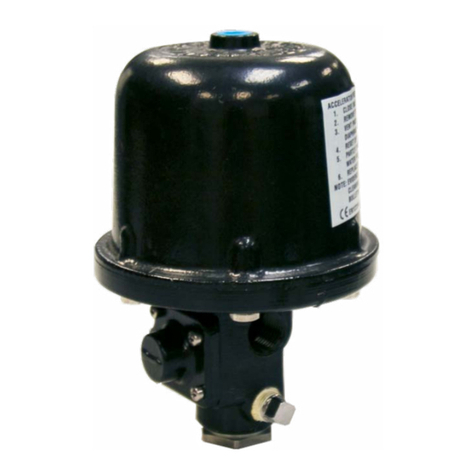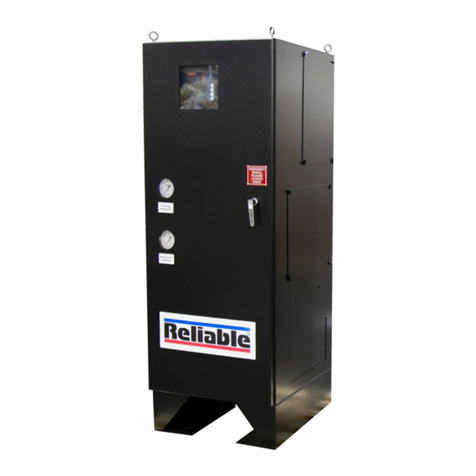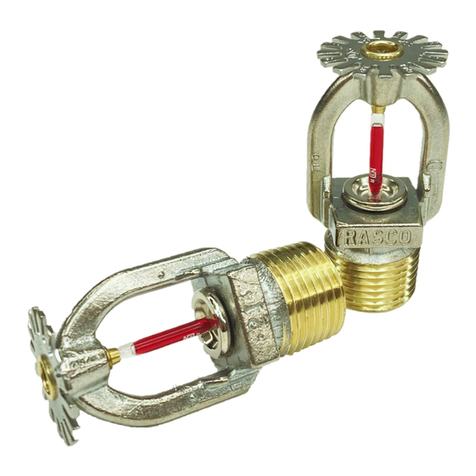Reliable N2-Blast DDX-LP PrePaK Maintenance manual

Reliable Automatic Sprinkler Co., Inc., 103 Fairview Park Drive, Elmsford, New York 10523
Model DDX-LP N2-Blast® PrePaK
Low Pressure Dry Pipe System
2” (50mm), 2-1/2” (65mm),
3” (80mm), 4”(100mm)
Bulletin 737 August 2020
Bulletin 737 August 2020
Instructions for
Installation, Operation,
Care and Maintenance
Low Pressure Dry Pipe System
8 psi - 24 psi (0.6 bar - 1.7 bar)
System Air/Nitrogen Pressure
General Description
The Reliable Model DDX-LP PrePak with integrated nitro-
gen generation (Sizes 2” (50mm), 2½” (65 mm), 3” (80 mm)
and 4” (100 mm)) is a completely self-contained, supervised
dry pipe system that can be readily installed within a floor
space of less than 7 ft2(0.65 m2). Refer to Fig. 1 for cabi-
net dimensions. Installation of the DDX-LP PrePak requires
just three piping connections: the water supply, the sprinkler
system and the drain. Reference locations of these piping
connections are shown in Fig. 1. Independent electrical
supplies are required for the optional system air compressor
(115 or 220 VAC) and the nitrogen generator (115 VAC).
Full assembly drawings for the units are available on the
Reliable Automatic Sprinkler Company website (www.reli-
ablesprinkler.com).
The Reliable Model DDX-LP N2-Blast®PrePak incorpo-
rates a South-Tek Systems FPS-900 pressure swing adsorp-
tion N2-Blast®nitrogen generator, complete with indepen-
dent air compressor, nitrogen storage tank, control system,
AutoPurge™. The nitrogen generator is completely wired,
tested, and integrated with the Model DDX-LP PrePak, and
supplies 98% pure nitrogen to the piping network to limit
electrochemical, galvanic, and micro-biologically influenced
corrosion (MIC). Operation and maintenance information
can be found in this bulletin as well as the South-Tek Sys-
tems website (www.southteksystems.com).
The heart of the Reliable Model DDX-LP PrePak is the
Model DDX-LP Dry Pipe Valve. The Reliable Model DDX-LP
Dry Pipe Valve is a hydraulically operated, mechanical valve
designed for use as a primary control valve in a low pres-
sure dry pipe valve system. The trim set used with the Model
DDX-LP Dry Pipe Valve contains the Reliable Model LP Dry
Pilot Actuator releasing device. This Actuator allows the sys-
tem air or nitrogen pressure to be considerably less than the
water supply pressure (see Table A). The following benefits
are a direct result of lower air pressure:
1. In refrigerated area systems, lower air pressure de-
creases the possibility of ice plugs that could impede
or prevent the flow of water to fire sprinkler heads in the
event of fire.
Note: N2-Blast®, Blast-off®, and AutoPurge™ are registered trademarks of South-Tek Systems, LLC.

2.
2. Lower air pressure allows for smaller capacity, lower
cost dehydration equipment, where required.
3. Lower air or nitrogen pressure can reduce water deliv-
ery time when the system actuates, and in some cases,
may eliminate the need for an accelerator.
4. For systems supplied with nitrogen, low supervisory
pressure reduces the quantity of nitrogen required to
maintain the system pressure.
The Model DDX-LP PrePak system is initially pressurized
with air provided by the factory-installed air compressor.
Supervisory pressure is provided and maintained by the
integral nitrogen generator and is monitored by a system
pressure switch.
Note: Compressed air is not to be considered dry air and
may contribute to internal corrosion of piping, and/or ice
plugs in system piping. The factory-installed air compres-
sor should be utilized for initial fill only and make-up air only
when the nitrogen generator is not active.
When a fire sprinkler operates, there will be a loss of air or
Nitrogen pressure in the sprinkler system piping which will
cause the Model LP-Dry Pilot Actuator to open. The opening
of this device allows the Model DDX-LP valve to flow water
into the system piping.
A Model B Hydraulic Manual Emergency Releasing sta-
tion is standard equipment in the Reliable DDX-LP PrePak. It
consists of an aluminum nameplate mechanically attached
to a ball valve. The valve handle in its OFF position is guard-
ed against accidental turning to the ON position (and sys-
tem discharge) by a nylon cable tie provided with the DDX-
LP PrePak assembly. The cable tie is designed to allow, in
case of an emergency, forceful turning of the valve handle
to the ON position.
Approvals
• The Model DDX-LP N2-Blast PrePak dry-pipe sys-
tem is FM Approved as a factory-assembled Dry-
pipe System to Approval Standard 1011/1012/1013,
Deluge and Preaction Sprinkler Systems.
• The Model DDX-LP dry-pipe valve and trim are FM
Approved and cULus Listed.
• The South-Tek N2-Blast® Model FPS-900-RS
nitrogen generator is FM Approved to Approval
Standard 1035, Nitrogen Generators for Corrosion
Mitigation.
Technical Data
1. The Reliable Model DDX-LP PrePak is rated for a mini-
mum water supply pressure of 20 psi (1.4 bar). The 2”,
2-1/2”, 3”, and 8” sizes are rated for a maximum pres-
sure of 250 psi (17.2 bar), and the 4” and 6” sizes are
rated for a maximum pressure of 300 psi (20.7 bar).
Water temperature must be maintained between 40°F
and 140°F (4°C and 60°C).
2. Friction loss, expressed in equivalent length of Sched-
ule 40 pipe and based on Hazen-Williams Formula is:
System Size Equivalent Length
2” (50 mm) 19.4 ft (1.3 m)
2½” (65 mm) 24.5 ft (1.8 m)
3” (80 mm) 28.9 ft (3.8 m)
4” (100 mm) 32.8 ft (17.7 m)
The equivalent length in the table above includes the
Model DDX-LP valve, supply manifold tee, supply side
control valve, and the section of pipe above the Model
DDX-LP valve.
3. Shipping Weight:
System Size Weight
2” (50mm)
950 lbs (431 kg)2-1/2” (65mm)
3” (80mm)
4” (100 mm) 1075 lbs (488 kg)
4. Refer to Figure 1 for dimensions.
The following is a list of Technical Data Bulletins which de-
scribe the valves and devices which are used in the system:
Device Reliable Bulletin #
(unless otherwise noted)
Model DDX Deluge Valve Reliable Bulletin 519
Model DDX-LP Dry Pipe System Reliable Bulletin 338
Low Air Pressure Switch Potter, 5401564
Alarm Pressure switch Potter, 5400928
Installation Requirements
The automatic sprinklers utilized with the DDX-LP PrePak
must be UL and/or ULC Listed or FM Approved, as appli-
cable.
The steel enclosure and all the interconnecting piping must
be located indoors in a readily visible and accessible loca-
tion and in an area that can be maintained at a minimum
temperature of 40°F (4°C). Note: Heat tracing is not permit-
ted. The Model DDX-LP PrePak operation is controlled by
the Model LP Dry Pilot Actuator. The introduction of moisture
into the system piping exposed to freezing temperatures can
create ice blockage, which could prevent proper system op-
eration. As a minimum, the air supply should be taken from
the area of lowest temperature within the protected area.
The air supply system must be carefully designed to pre-
vent plugging by frost deposits. Special requirements, such
as those in FME&R “Installation Guidelines for Refrigerated
Storage” may need to be incorporated.
Hydrostatic Testing of DDX-LP Valves and
DDX-LP Systems
As required by NFPA 13, fire sprinkler systems with work-
ing pressures up to and including 150 psi are to be hydro-
statically tested at a water pressure of 200 psi. Fire sprinkler
systems with working pressures above 150 psi are required
to be hydrostatically tested at 50 psi above the system work-
ing pressure. In addition to the hydrostatic tests described
above, dry pipe systems require an additional low pressure
air test.

3.
Fig. 1

4.
In some cases, hydrostatic testing (in accordance with the
NFPA 13 requirements noted above) will result in pressures
that exceed the working pressure of the valve and trim kit for
the two-hour test period.
The valve and applicable trim kit have been tested, ap-
proved and listed under these conditions and as such, hy-
drostatic testing in accordance with NFPA 13 is acceptable.
In addition, the clapper can remain in the closed position and
the trim kit need not be isolated, as each has been designed
to withstand hydrostatic testing as required by NFPA 13.
Subjecting the valve and trim to pressures higher than
their rating is limited to the hydrostatic test as referenced
by NFPA13. It does not address the occurrence of a “wa-
ter hammer” effect, which may damage the valve. A “water
hammer” in the water supply piping of the valve can cre-
ate pressures in excess of the rated pressure and should
be avoided by all necessary means. This condition may be
created from improper fire pump settings, underground con-
struction work, or an improper venting of trapped air in the
water supply piping.
System Supervisory Pressure Requirements
The DDX-LP PrePak includes gauges indicating the air/
nitrogen and water pressures on the Model DDX-LP sys-
tem. Table A specifies the air or nitrogen pressure to be
maintained in the sprinkler system piping based on the wa-
ter supply pressure. The factory installed Pressure Mainte-
nance Device in the unit automatically regulates makeup air
or nitrogen flow to maintain pressure with normal leakage
from system piping, while restricting the flow of makeup air
or nitrogen to the system. Please note that when the optional
Model B1 Accelerator is to be utilized to expedite water-de-
livery time, the air or nitrogen pressure must be not less than
15 psi (1.0 bar).
The factory-installed system low air pressure switch may
need on-site adjustment to correspond with the air pressure
values found in Table A. Adjustment, if required, should be
made according to Potter Bulletin 5401564 included with the
switch.
System Electrical Requirements
All 24 VDC electrical connections in the Reliable Model
DDX-LP PrePak are translated to a water tight terminal box
mounted on the inside of the enclosure. All field wiring con-
nections are made at this terminal box.
A separate power connection is provided for the optional
air compressor.
Note: The air compressor must be connected to a
grounded metallic, permanent wiring system, or an equip-
ment grounding terminal or lead on the product. Power sup-
ply wiring must conform to all required safety codes and be
installed by a qualified person. Check that the supply volt-
age agrees with that listed on compressor nameplate.
Maintenance
The Reliable DDX-LP PrePak and associated equipment
shall periodically be given a thorough inspection and test.
NFPA 25, Standard for Inspection, Testing and Maintenance
of Water Based Fire Protection Systems, provides minimum
maintenance requirements. Systems should be tested, op-
erated, cleaned and inspected at least annually, and parts
replaced as required. Periodically open the condensate
drain valve beneath the air tank to drain any condensate ac-
cumulation. Reliable Technical Bulletins 338 and 519 pro-
vide additional information for maintaining the Model DDX-
LP Deluge Valve.
System Setup (Refer to Figure 2)
1. Close the main valve controlling water supply to the
Model DDX-LP deluge valve. Also, close the two ¼”
valves supplying air or nitrogen to the system.
2. Close the pushrod chamber supply valve.
3. Open the main drain valve and drain the system.
4. Open all drain valves and vents at low points through-
out the system, closing them when flow of water has
stopped.
5. Open the Manual Emergency Release valve. Note: The
above steps accomplish the relieving of pressure in the
pushrod chamber of the deluge valve.
6. Push in the plunger of ball drip valve to force the ball
from its seat, and drain any water in the alarm line.
7. Push in and rotate the deluge valve’s external reset knob
counter-clockwise (when facing valve) until you hear a
distinct clicking noise, indicating that the clapper has
reset. Note: The reset knob can be rotated only after
pressure in the pushrod chamber is reduced to atmo-
spheric conditions (0 psig).
8. Inspect and replace any portion of the sprinkler system
subjected to fire conditions.
Water Pressure psi (bar) System Air or Nitrogen Pressure
psi (bar)
Maximum Not Less Than
20 (1.4) 8 (0.6)
30 (2.1) 10 (0.7)
50 (3.4) 12 (.8)
75 (5.2) 13 (.9)
100 (6.9) 15 (1.)
125 (8.6) 16 (1.1)
150 (10.3) 17 (1.2)
175 (12.1) 18 (1.2)
200 (13.8) 19 (1.3)
225 (15.5) 21 (1.4)
250 (17.2) 22 (1.5)
275 (19.0) 23 (1.6)
300 (20.7) 24 (1.7)
Table A
Notes:
1. Supervisory air or nitrogen pressure should not exceed 30 psi (2.1
bar). Excess pressure may result in damage to the actuator.
2. Fastest valve operation is achieved with supervisory air or nitrogen
pressure indicated; however, pressure must never be less than the
minimum specified in the table above.
3. Air maintenance devices that maintain a constant pressure are
recommended; however, if a tank-less compressor is used, the
“compressor on” setting of the pressure switch must never be lower
than the minimum pressure in the table above.

5.
9. Verify that the following valves are in their respective po-
sitions prior to continuing:
Manual Emergency Release - open
Main Drain Valve - open
Alarm Line Valve - open
Alarm Test Valve - closed
Condensate Drain valve - closed
Air/Nitrogen Supply Valves - closed
10. Open pushrod chamber supply valve and allow water
to fill the pushrod chamber. Close the Manual Emer-
gency Release valve after any trapped air has had a
chance to escape from the deluge valve’s pushrod
chamber.
11. Upon seeing this solid flow of water coming out of the
Model LP Dry Pilot Actuator, open the Rapid-Air Fill
Valve thereby rapidly applying compressed air or ni-
trogen into the Model LP Dry Pilot Actuator and the
sprinkler system until the pressure conforms to Table
A levels, as indicated by the system air pressure
gauge. The Model LP Dry Pilot Actuator will eventually
close during this pressurizing process and water will
stop flowing through the drain tube. At this point, the
pressure gauge on the pushrod chamber pressure will
equalize to the available water supply pressure. Once
the actuator is set up correctly, close the Rapid-Air Fill
Valve and open the Regulated Air Shutoff Valve.
Note: For systems using nitrogen as the primary
source, the system may be set up using the nitrogen
source following the steps above. The air compres-
sor, if present, may then be placed into operation as
the backup pneumatic source.
12. Open the alarm line valve.
13. If the Model B1 Accelerator Kit is installed, open valve
P. Prior to opening valve P, be sure that the Model B1
Accelerator has been successfully reset per Reliable
Technical Bulletin 323.
Note: The B1 Accelerator requires a minimum of 15
psi (1,0 bar) supervisory air or nitrogen pressure for
proper operation.
14. Slightly open the main valve controlling water supply
to the Model DDX-LP Deluge Valve. This will begin
to fill the deluge valve beneath the clapper with wa-
ter. Once any trapped air has been vented, close the
main drain valve. Observe if water leaks through the
ball drip valve into the 1” drain manifold through the
clear tubing. If no leakage occurs, the deluge valve
clapper is sealed. Fully open the main valve control-
ling the water supply to the Model DDX-LP Deluge
Valve and that it is properly monitored
15. Verify that the pushrod chamber supply valve is open.
16. Secure the handle of the Model B Manual Emergency
Station in the OFF position with a nylon tie (supplied
with the assembly).
Inspection And Testing Of The DDX-LP PrePak
Systems (Refer to Figure 2)
1. Water supply — Verify that the valve controlling water
supply to the deluge valve is opened fully and properly
monitored.
2. Pushrod Chamber supply — Verify that the valve sup-
plying water to the pushrod chamber is open.
3. Other trimming valves — Verify that the alarm line valve
is open as well as all of the pressure gauge valves. The
main drain valve, alarm test valve, and condensate
drain valve should be closed.
4. Ball drip valve — Push in on the plunger to be sure the
ball check is off its seat. If no water appears, the deluge
valve’s water seat is tight. Inspect the small bleed hole
located on the underside of the Model DDX-LP Deluge
Valve pushrod chamber for leakage.
5. System air pressure — Verify that system air pressure
is in conformance with the values posted in Table A for
the supply water pressure.
6. Releasing device — Check the outlet of the (Model LP
Dry Pilot Actuator and Model B Manual Emergency Sta-
tion) for leakage. Also verify that tubing drain lines from
releasing devices are not pinched or crushed which
could prevent proper releasing of the deluge valve.
7. Testing alarms — Open the alarm test valve permit-
ting water from the supply to flow to the alarm pressure
switch and to the mechanical sprinkler alarm (if pres-
ent). After testing, close this valve completely. Push
in on the plunger of ball drip until all of the water has
drained from the alarm line.
8. Operational test — Open the Model B Manual Emer-
gency Station or, alternatively, reduce air/nitrogen pres-
sure on the system. Note: An operational test will cause
the Deluge Valve to open and flow water into the sprin-
kler system.
9. Secure the Model B Manual Emergency Station in
the OFF position with a nylon tie (included with the as-
sembly) after the deluge valve is reset.
Testing the Model DDX-LP Deluge Valve
Without Flowing Water (Refer to Figure 2)
1. Close the valve controlling water supply to deluge valve
and open the main drain.
2. Verify that the pushrod chamber supply valve is open,
allowing water to enter the pushrod chamber.
3. Close the air/nitrogen supply to the sprinkler system.
4. Decrease pneumatic pressure in the system by opening
the condensate drain valve, until the Model LP Dry Pilot
Actuator operates. Doing so will result in a sudden drop
of water pressure in the deluge valve pushrod chamber.
5. Reset the system per the directions listed in “System
Setup” section of this bulletin.
(cont. bottom of page 8)

6.
Fig. 2
Model DDX-LP Low Pressure Dry Pipe System
Valve Legend
(Note: Some items omitted for clarity)

7.
Fig. 3

8.
Fig. 4
Draining Excess/Condensate Water From System
1. Close the main valve controlling water supply to the Mod-
el DDX-LP system.
2. Close the pushrod chamber supply valve, and open the
main drain valve.
3. Slightly open the condensate drain valve until all water
has drained, then close.
Note: Leaving the condensate drain open for an extended
period of time may allow excess air/nitrogen to bleed off and
result in accidental release of the Model LP Dry Pilot Actua-
tor and/or the Model DDX-LP valve.
4. Close the main drain valve. Allow the system air/nitrogen
pressure to return to its previous level. Open the pushrod
chamber supply valve first, and then open the main valve
controlling water supply to the system.

FPS-900-RS Nitrogen Generator
General
This manual provides instruction for the proper use and
maintenance of South-Tek Systems N2-Blast®FPS-900-
RS. South-Tek Systems and Reliable are not responsible
for damages when using this in manners not approved
by South-Tek Systems and Reliable. The user(s) of this
document should confer any questions with a qualified
South-Tek Systems representative on its commissioning
and correct use. Please contact South-Tek Systems with
any question or concerns at:
South-Tek Systems, LLC
2940 Orville Wright Way Ste 600
Wilmington, NC, 28405
Tel: (888) 526-6284
Email: [email protected]
http://www.southteksystems.com/
Important Information
All personnel (and their supervisors) installing, operating,
and maintaining the N2-Blast®must read and fully under-
stand this manual prior to installing, operating or perform-
ing maintenance. The N2-Blast®produces nitrogen (N2) at
a low flow rate, which quickly dissipates into the air. N2
gas is not poisonous, but do not directly inhale since high
concentrations can cause asphyxiation. Install the unit in
a well-ventilated room that is not sealed off from normal
living space air changes. All personnel involved with the
installation, operations, and maintenance of the N2-Blast®
must follow safe working practices, including OHSA and
local health/safety code regulations.
Safety Guidelines
The following section outlines the basic safety consid-
erations about installation and operation of the N2-Blast®
FPS-900-RS. For other equipment used with the nitrogen
generator, such as external air compressors, and dryers,
refer to the manufacturer’s safety guidelines.
Using the N2-Blast®FPS-900-RS correctly is impor-
tant for safety and trouble-free operation. Wrong use can
cause damages to the system or can lead to incorrect gas
supply. The nitrogen generator produces nitrogen at a low
flow rate, which quickly dissipates into the air. Nitrogen
is not poisonous, but do not directly inhaled, since high
concentrations, can cause asphyxiation. Install the unit
in a well-ventilated room, unsealed off from normal living
space air changes.
Warning: Install the unit in a within a well-ventilated room,
one that is not sealed off from normal living space air
changes.
Read carefully and act accordingly before operating or
repairing the unit:
• The operator must use safe working practices and
rules when running the nitrogen generator.
• The owner is responsible for always keeping the
unit in safe working conditions.
• Always use approved parts when performing main-
tenance and repairs. Make sure that replacement
parts meet or exceed the original parts’ specifica-
tion.
• Only competent individuals, trained and autho-
rized, can install, operate, perform maintenance
and repair.
• Isolate incoming and outgoing pressures to the
generator, and depressurize the service or repair
section before performing any mechanical work,
including changing the filters.
• Vent the nitrogen generator’s exhaust gas outside
or to a large, well-ventilated room to avoid suffoca-
tion due to lack of oxygen.
• Wear safety glasses if the cabinet door is open
while the machine is running.
• Use ear protection when the equipment is running.
NOTE: Always following local and site safety regula-
tions in conjunction with this manual. Correct use of
the nitrogen generator is important for personal safety.
Incorrect safety practices can cause damage to the in-
dividual and equipment.
Follow safe working practices, OSHA, and local health and
safety regulation when maintaining the N2-Blast® FPS-900-
RS.
Air Supply
The N2-Blast®FPS-900-RS includes a built-in air com-
pressor to supply gas to the nitrogen generator. It is not for
performing quick fills; a separate suitable air compressor
should be used to fill the system.
9.

Electrical Requirements
The N2-Blast®FPS-900-RS requires 120VAC / 50-60hz /
1ph and draws < 8A. A 240VAC option is also available. It
has a built-in 20A over-current protection device and comes
with a standard 3-prong US power cord for the electrical
connection (unless otherwise specified). It comes with UL
508A ICP certification, and the electrical schematics are
available upon request.
Site Specifications
Unless designed otherwise, install in a nonhazard-
ous indoor location with temperatures between 40-100°F
(4°- 38°C). For ease of maintenance, troubleshooting, and
minimizing pressure drop, install the equipment in the same
area. Leave enough space around the generator and other
equipment for routine maintenance.
Key Features
Air Compressor
An oil-less internal air compressor has an engineered
dampening system reducing vibration and noise through-
out the cabinet. The air compressor has a pre-filter to catch
small particulates that can cause damage. The recom-
mended replacement for the pre-filter is 1000 run hours
or 1-year, whichever comes first. Dirtier environments may
need more frequent changes. Consult with the supplier for
a different filter maintenance schedule if installing in a dirty
environment.
Air Filters
The generator has an air inlet pre-filters and two filters
between the compressed air and O2separation beds - the
particulate and coalescing. The 5-micron particulate filter
catches the bulk particles, and the 0.1 micron coalescing
catches the remaining smaller particles. Both filters feature
an auto-drain that drains any water buildup within the filter
housing. These drain lines are on the cabinet’s bottom right
side. Connect these drain lines to a safe location.
Programmable Logic Controller
An integrated PLC within the cabinet that features smart
timing to maximize the generator’s performance. It controls
the valve timing and sequencing to move compressed gas
throughout the system. It also has a smart feature to auto-
matically switch between different “modes” based on the
current run stages (see Chapter 7: System Operation for
more about the unit’s functionality).
Safety Relief Valves
The installed ASME safety relief valves add additional
safety to protect component failures.
Nitrogen Tank
A nitrogen tank inside the cabinet comes with ball
valves, safety relief, and a gauge.
Automatic Cut-In and Cut-Out
The generator starts and stops based on a pressure
switch. Do not adjust the factory preset cut-in and out pres-
sure without first consulting with South-Tek Systems.
AutoPurge™
Designed to cycle nitrogen continuously through the
fire protection system, the AutoPurge™ consists of a ball
valve, strainer, and a tunable orifice that is set based
upon the capacity of the system. The device connects
to a 1/2” NPT outlet on the system preferably at a remote
location from the system riser, in an area where water will
not collect, and is accessible (see Figure 10). When set
properly the AutoPurge™ is designed to ensure 98%
minimum purity throughout the system within two (2)
weeks. A convenient outlet port is provided for connec-
tion of a Quick-Check Portable® Nitrogen Purity Sensor
(not provided; order separately).
Patented BlastOff®– Leak Detection System
The “BlastOff®Leak Detection” is a patented feature
which sends an alarm if it detects a possible gas leak. The
alarm signal can be an audible, visual, and dry contact
connection to the “Building Management System (BMS)”.
Power cycle the unit to reset the alarm but avoid doing this
without finding the cause, as it will shorten the generator’s
life.
N2-Blast®FPS-900-RS Specifications
• Nitrogen Purity 98.5+%
• Integrated Installation in Reliable PrePak
• Display Hours/Power on/Operating
• N2Storage Pressure 60-70 PSIG (±5%)
• Cabinet Port Connections 1/2” NPT Female
• Electrical 110-220V / 50-60Hz / 1Phase; 20 Amp
Breaker
• Compressor Integral / Oil-Free
• Ambient Temperature 40° to 100°F
• Noise Level (dbA) < 90 dbA
Operation
The nitrogen generator uses valve sequencing to pro-
duce nitrogen. The design meets specifications of a fire pro-
tection system. Consult with South-Tek System for written
approval before performing any field changes or custom-
ization. Unauthorized changes void all warranties and may
cause damages or malfunctions to the system.
This section describes the major control functions and
instrumentations associated with the nitrogen generators.
All programs are proprietary and password protected from
the factory. Do not alter any controls or instrumentations.
Changes without South-Tek Systems’ written consent voids
the performance specifications.
10.

Controller Modes
To utilize the buttons on the front of the controller the
unit must be in “S” or “Switch” mode and unlocked. If the
system is displaying “LOCK”, the Mode Select Button may
be pressed and held to unlock the controller (repeat this
step if a system lockout is desired). To change to Switch
Mode, press the Mode Select Button when the controller
is unlocked until the System Mode Indicator displays “S”.
This mode allows access to two features:
• Alarm Simulation (5) – Hold the Alarm Simulation
Button for 3 seconds or press the filter replacement
reset button 3 times within 3 seconds to activate. This
will simulate an alarm condition and trip the alarm dry
contact in the unit for 2 seconds so that proper func-
tioning can be confirmed.
• Filter Change Reset (0) – When a new FRP (Filter Re-
placement Kit) is installed, the 1000- hour filter change
time must be reset. After replacing the filter elements,
press and hold the Filter Change Reset Button for 7
seconds. An audible beep will confirm that the time is
reset and filter alarm will be reset. (Note: this will also
trigger the Customer Alarm Relay for one second)
Normal Run/Standby Mode (run/StdbY)
“Run” mode is when the FPS-900-RS is producing ni-
trogen and supplying it to the storage tank. The system will
automatically enter “Standby” mode when the tank is fully
pressurized (70 PSIG ±5 PSIG). It will remain in “Standby”
mode until the tank pressure falls 7-10 psig.
To run the system in normal run mode:
1. Connect power to the system.
2. Open the nitrogen generator’s 3-way outlet ball
valve to nitrogen-out position.
3. On the nitrogen tank, open the gas inlet valve.
4. Push the On/Off toggle button on the upper right
control panel to the “On” position (up) and the
system will automatically turn on and start filling
the storage tank with nitrogen.
To stop the system:
1. Switch the nitrogen generator’s 3-way outlet ball
valve to the bypass position.
2. System will automatically stop once it reaches the
cut-out pressure of approximately 65-75 PSIG.
3. In the case of an emergency shut off, push the
On/Off toggle button on the upper left control panel to
the “Off” position. The unit will shut down immediately.
Alarm Mode
When an alarm mode is activated, it will trigger the
audible buzzer, alarm contact, and flash the cause of the
alarm on the screen. The customer alarm contact wiring
can be viewed on the supplied wiring diagram. The cus-
tomer alarm dry contact is constantly energized and will
constantly illuminate the LED indicator on top of the con-
tact. This is so when there is no power or power is lost on
the system, the contact will de-energize and show a fault
condition. The alarm contact has a max rating of 6A at
250VAC and 2A at 24VDC.
Bypass Mode (BPASS)
During the 30-minute fire protection piping system fill
test or an issue with the generator is detected, the opera-
tor can switch the system into manual bypass mode by
turning the handle on the 3-way ball valve to the bypass
position. With the handle in the “Bypass Mode”, the by-
pass alarm triggers the audible buzzer, alarm contact,
and flashes “BPASS” on the controller’s 7-segment dis-
play. The alarm will turn off once the handle is back to
normal run position.
BLASTOFF® Alarm Mode (B-Off)
The nitrogen generator activates a BlastOff® Alarm
when it detects potential leaks or nitrogen being overdrawn.
The BlastOff® Alarm will trigger the audible buzzer, alarm
contact, and flash “B-OFF” on the controller’s 7-segment
display. Inspect and test the system for leaks and com-
ponent failures. Power cycle the unit to reset the alarm but
avoid doing this without finding the cause, as it will shorten
the generator’s life. Contact South-Tek System or the local
installer for further troubleshooting.
Low System Pressure Alarm Mode (Lo-n2)
The low system pressure alarm activates when a sys-
tem pressure is detected below the normal functioning
limits of the nitrogen generator. This may be from an is-
sue with the generator, a supply valve being shut off, or
caused by a large leak in the fire protection system.
Power Loss Alarm Mode (-----)
The Power Loss alarm activates when the nitrogen
generator loses power for any reason. This will cause the
alarm contact to trigger.
Filter Replacement Alarm Mode (FILTr)
Once the generator has been running for 1000 hours
or more, the filter replacement alarm will activate. Re-
place the filters according to Section 9 Maintenance. Af-
ter replacing the filter elements, press and hold the Filter
Change Reset Button for 7 seconds. An audible beep
will confirm that the time is reset, and filter alarm will shut
off if it is active. (Note: resetting this will also trigger the
Customer Alarm Relay for one second)
Start-up Procedures
Use caution when working with pressurized gas.
Always leak check every line before using the system.
Note: Line leaks will cause the N2-Blast®FPS-900-RS to
run excessively, shortening its life and possibly causing
excessive wear on the compressor.
1. Visually inspect the unit to ensure no damage oc-
curred during shipping and handling.
2. Check the power connection is correct.
3. Turn the 3-way ball valve on the system output to the
“Bypass” position.
4. Open the inlet ball valve on the nitrogen storage tank
if it is closed.
11.

Air Intake Filter
The integrated air compressor, of the N2-Blast® FPS-900-RS,
has an air intake pre-filter. It prevents particles from entering the
compressor housing and damaging internal components. Re-
place this filter once per year or every 1000 hours, whichever
comes first. To do so, remove the pre-compressor filter cap by
twisting it clockwise. Remove the old element and use a clean
dry cloth to clean the filter bowl before installing the new ele-
ment.
Air Filter Replacement
The particulate and coalescing filters, after the air compres-
sor, are designed to capture particulate
and moisture prior to entering the rest of the system. These filters
need to be replaced once per year or every 1000 hours, which-
ever comes first.
Note: Annual Filter replacement kit part # FRP-007
Follow these instructions to replace filters:
1. Turn off the unit and remove the front cabinet door.
2. Locate the air filters on the bracket in the top-left of the
cabinet (see Figure 6).
3. Make sure the filters are completely depressurized by
checking the pressure gauge.
4. Remove both filter bowls by turning them counter-
clockwise.
5. After removing the filter bowls, rinse debris out of the
bowls with warm water.
6. Dry the bowls with a clean dry cloth and replace old
O-rings with the ones in the kits and lubricate the seals.
7. Change the filter elements:
a. Particulate Element - Pull the plastic element hous-
ing out of the filter bowl. Twist off the black plastic cover
and pull off the particulate element. Install the new ele-
ment in the reverse order.
b. Coalescing Element - Twist the coalescing element
counter-clockwise. Install the new element in the re-
verse order.
8. After replacing all elements and O-rings and cleaning
the bowls, install the bowls back to their corresponding
filter housings. Hand-tighten only.
After replacing the filters, check the filter bowls for leaks by turn-
ing on the unit momentarily. Turn the unit off to reinstall the front
cover and then power the unit back on. Once powered up, the
air compressor will turn on and the system will start producing
nitrogen.
Key Contacts
Contact your local provider/installer for any questions about
the performance and/or maintenance of the system. They will
be best suited to answer your questions and your quickest solu-
tion on any issues you may have. If they cannot be reached,
contact the manufacturer at:
South-Tek Systems, LLC.
tel (888) 526-6284 fax (910) 332-4178
Email: [email protected]
FAQS
1. Power Issues
If the N2-Blast®FPS-900-RS does not have power, the produc-
tion and storage of nitrogen will become apparent once the stor-
age pressure drops.
• Check the power cord.
• Has the building’s circuit breaker or GFCI tripped? Locate
the breaker and reset. If breaker continues to trip, you may
have that circuit overloaded.
2. Pressure Issues
The N2-Blast®FPS-900-RS will produce and store Nitrogen (N2)
at 70 (+/-3) psig. Once the storage tank reaches 70 (+/-3) psig,
the system will go into Standby Mode. When the pressure drops
by about 7-10 psig, the system will go into Run Mode and be-
gin to refill the storage tank. Contact the manufacturer or factory
trained technician if system does not properly operate within
these ranges
Nitrogen Pressure Check:
The pressure gauge on the storage tank should be between
60 and 70 psig. If the pressure is low, check the following:
• Check the power.
• Find out if fire protection system is being tested.
• Check for leaks throughout system.
3. Leaks
As with any gas system, only use a spray bottle on non-electri-
cal equipment to find leaks. Fix or replace leaking fittings or old
hose. Push-to-connect fittings will show bubbles and typically
have up to a 5ccm acceptable leakage rate. Contact your local
provider/installer for help.
12.
5. Push the power button on the top left of the cabinet to
the “On” position (up). The air compressor will power
on if the storage tank is under pressurized. If neither
the compressor nor PLC display power on, check
the wiring and supply power to the generator.
6. Once the system is running, the pressure gauge will
increase to 65-70 PSIG within 30 minutes or less.
While it is running, check the system for leaks to en-
sure proper functionality.
a. Once it reaches 65-70 PSIG, the system will en-
ter “Standby” mode and automatically shut off the
internal air compressor. Check the controller on the
control panel for the “StdbY” display.
b. Once in standby, note the pressure reading on the
tank pressure gauge. Monitor the pressure for the
next 5 minutes for any loss in pressure. If there is
a pressure drop, check for leaks around connection
fittings, otherwise proceed to the next step.
7. Switch the 3-way ball valve on the system output to
the “Nitrogen Out” position and the system will turn
on and fill the storage tank with nitrogen.
8. Completely fill the storage tank and allow the nitrogen
generator to go into standby mode.
9. Once in standby mode, monitor the tank pressure
gauge for 5 minutes and ensure no significant leaks
are in the sprinkler system.

13.
Fig. 5
1" NPT F X 1/2" NPT
F REDUCING TEE
VERTICAL PIPE INSTALLATION

Fig. 6 - Nitrogen Generator Filter Locations
13.

Notes:
(1) Manifold size in PrePak may differ from system size (see Figure 1). Customer to confirm size of supply pipe
to PrePak and order appropriate transition fittings if necessary.
(2) System capacity based on 20 psi supervisory pressure. Air compressor sizing may differ if sprinkler system
has an uncommon volume. If “0 = None” option is chosen, customer to provide separate compressor or other
pneumatic source.
DDX-LP Valve Size/System
Side Control Valve
X
Air Compressor
Y
System Air Devices
Z
2 = 2” 0 = None 8 = Nitrogen Generator
0 = 2-1/2” 1 = 1/2 HP 115 VAC
(Systems up to 580 gallons)
9 = Nitrogen Generator &
Model B1 Accelerator
3 = 3” 2 - 1 HP 115 VAC
(Systems up to 1170 gallons)
4 = 4” 3 = 1/2 HP 220 VAC 60 Hz
(Systems up to 580 gallons)
A = 2” w/ System Side Control
Valve
4 = 1 HP 220 VAC 60 Hz
(Systems up to 1170 gallons)
B = 2-1/2” w/ System Side Con-
trol Valve
C = 3” w/ System Side Control
Valve
D = 4” w/ System Side Control
Valve
655 X(1) 3 0 0 Y(2) Z 0
Ordering Information: Model DDX Type DDX-LP PrePak with N2-Blast®Nitrogen Generator
Reliable Automatic Sprinkler Co., Inc.
(800) 431-1588 Sales Offices
(800) 848-6051 Sales Fax
(914) 829-2042 Corporate Offices
www.reliablesprinkler.com Internet Address
Manufactured by
Recycled
Paper
Revision lines indicate updated or new data.
EG. Printed in U.S.A. 09/20 P/N 9999970550
The equipment presented in this bulletin is to be installed in accordance with the latest published Standards of the National Fire Protection Association, FM
Global, or other similar organizations and also with the provisions of governmental codes or ordinances whenever applicable.
Products manufactured and distributed by Reliable have been protecting life and property for almost 100 years.
Other manuals for N2-Blast DDX-LP PrePaK
1
This manual suits for next models
1
Table of contents
Other Reliable Industrial Equipment manuals
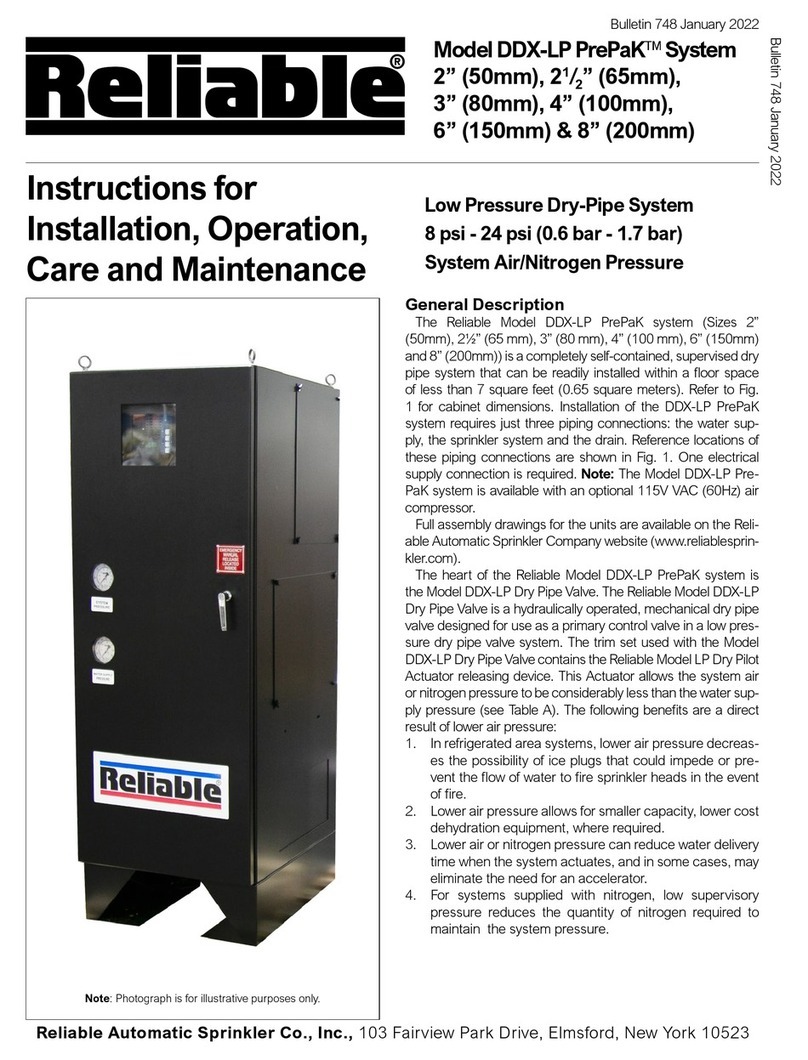
Reliable
Reliable DDX-LP PrePak Maintenance manual
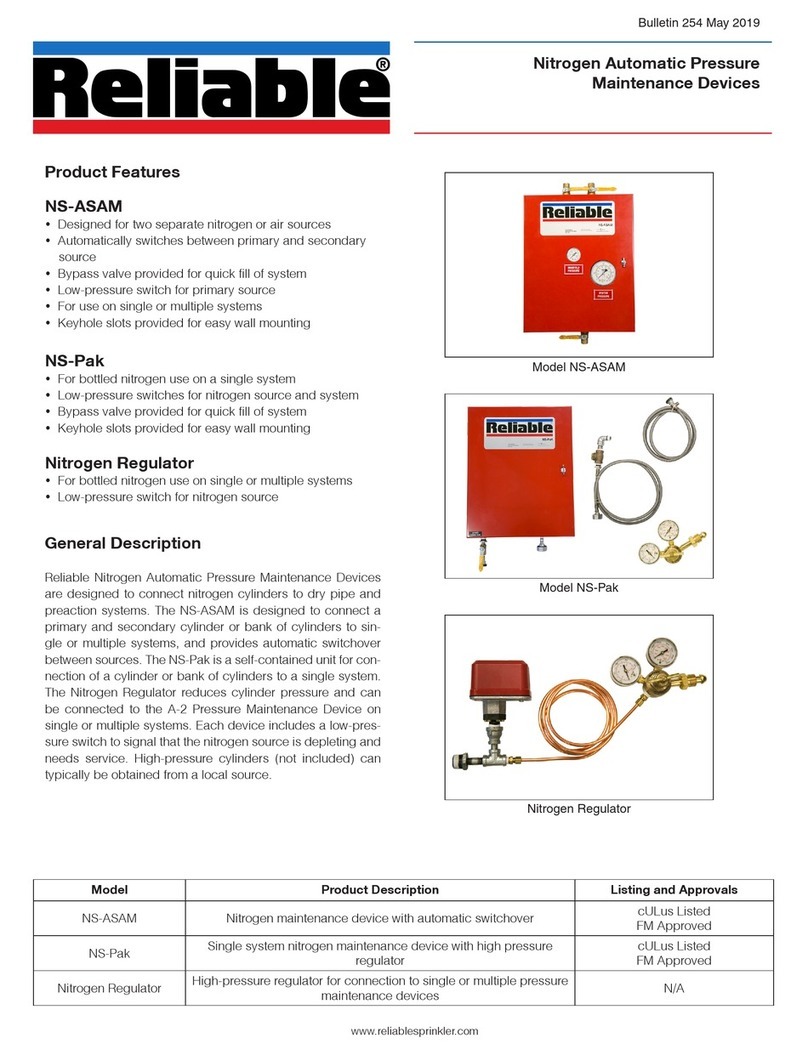
Reliable
Reliable NS-ASAM Manual
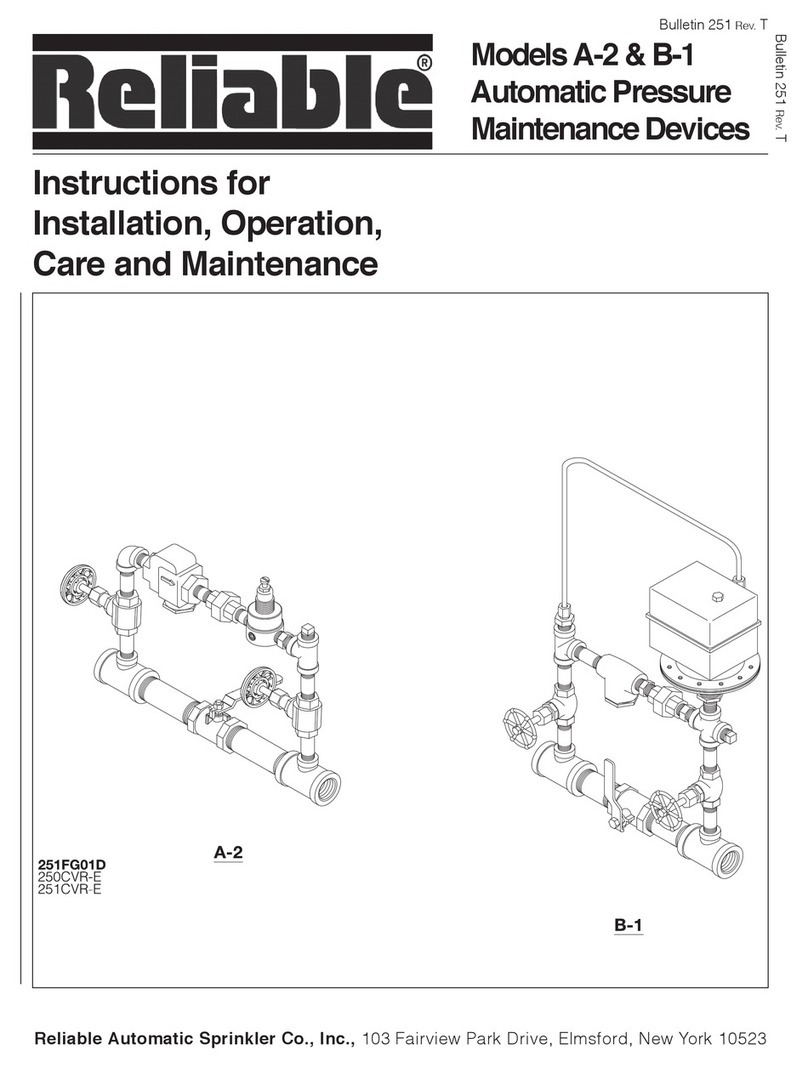
Reliable
Reliable A-2 Maintenance manual
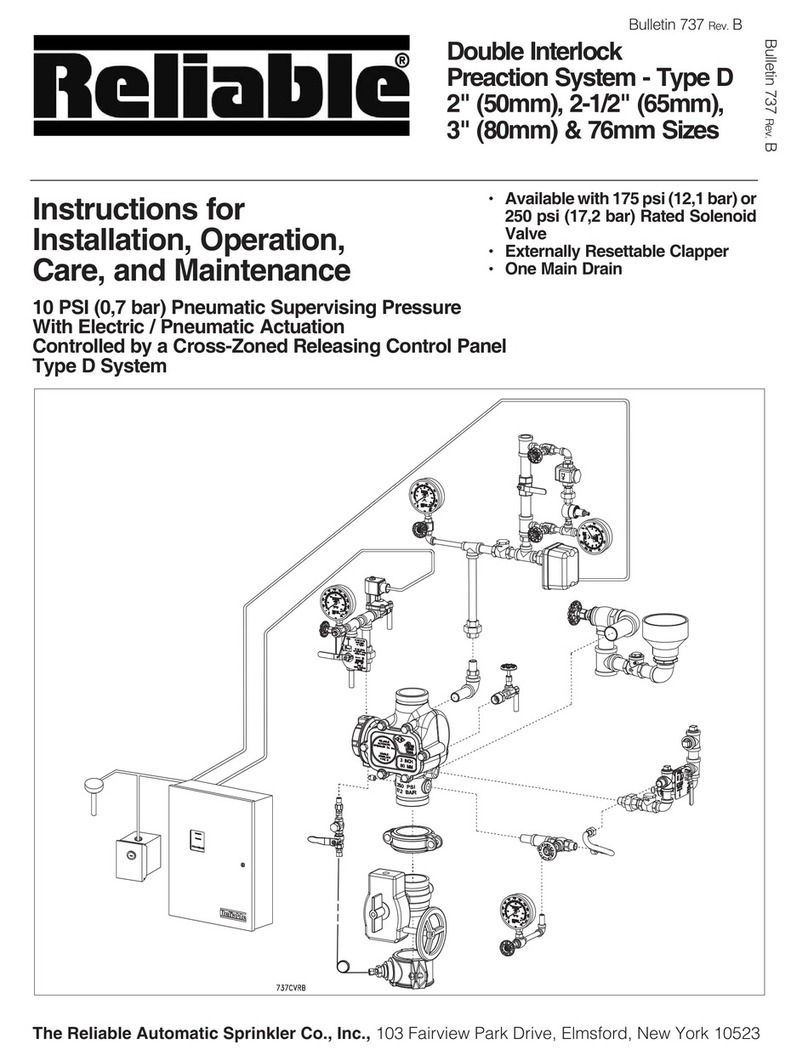
Reliable
Reliable Double Interlock Preaction System D Maintenance manual
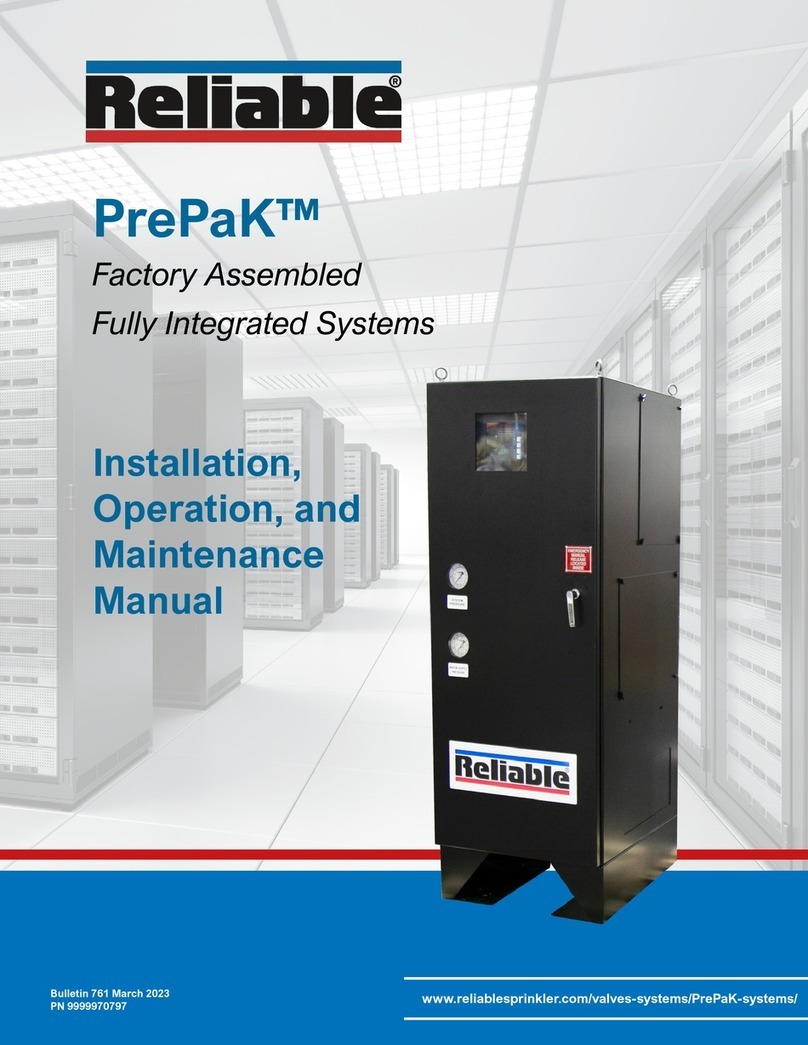
Reliable
Reliable DDX PrePaK User manual
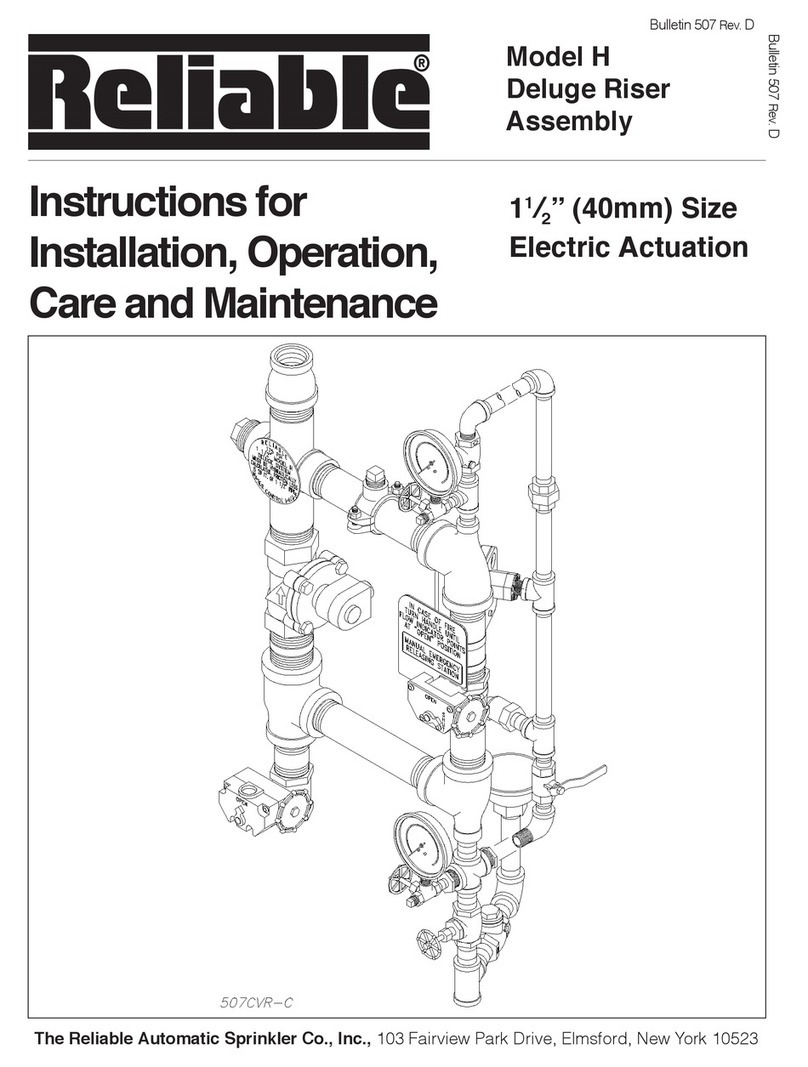
Reliable
Reliable H Deluge Riser Maintenance manual
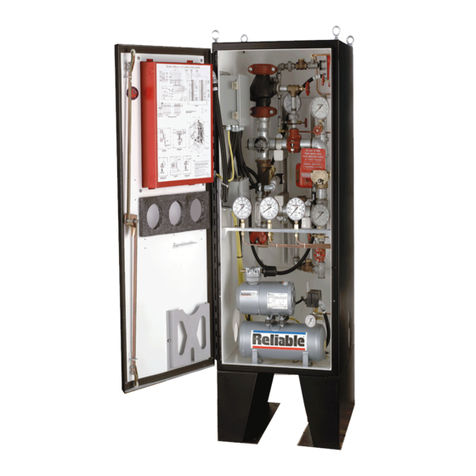
Reliable
Reliable H PrePak User guide

Reliable
Reliable H PrePak Maintenance manual
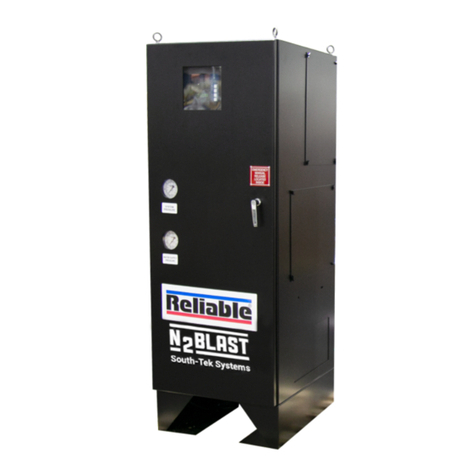
Reliable
Reliable N2-Blast DDX Maintenance manual
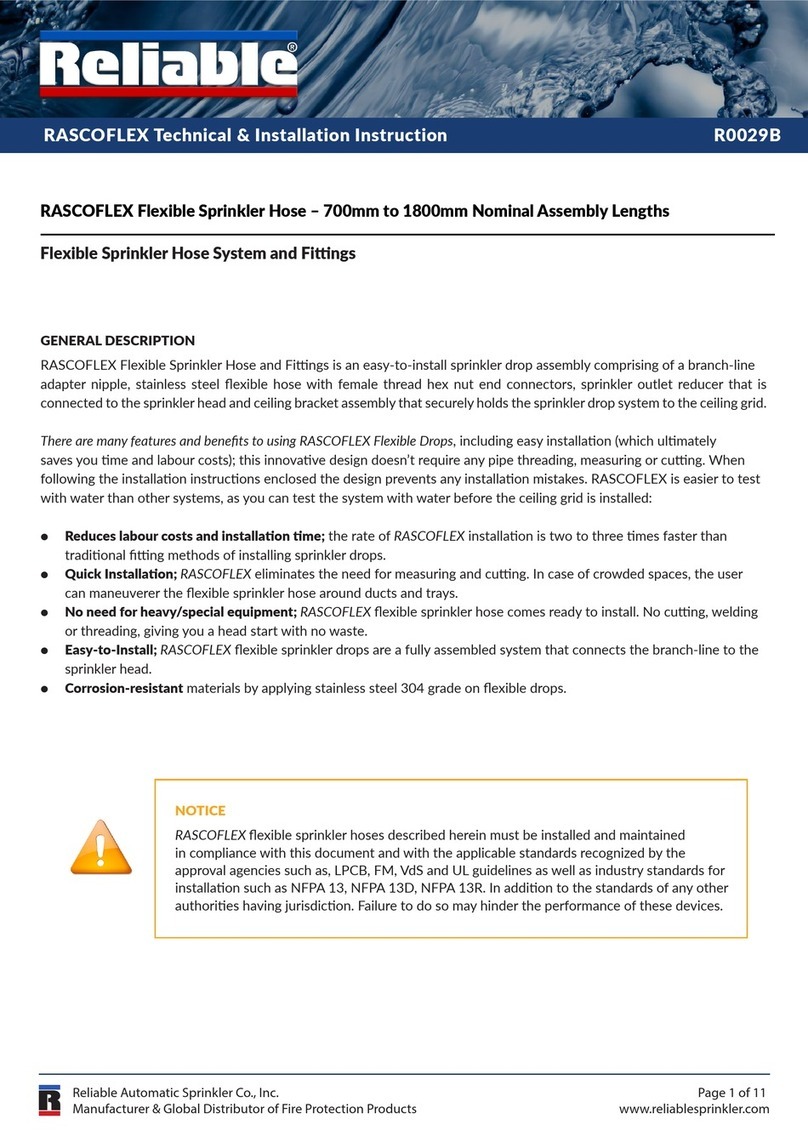
Reliable
Reliable R0029B User manual
